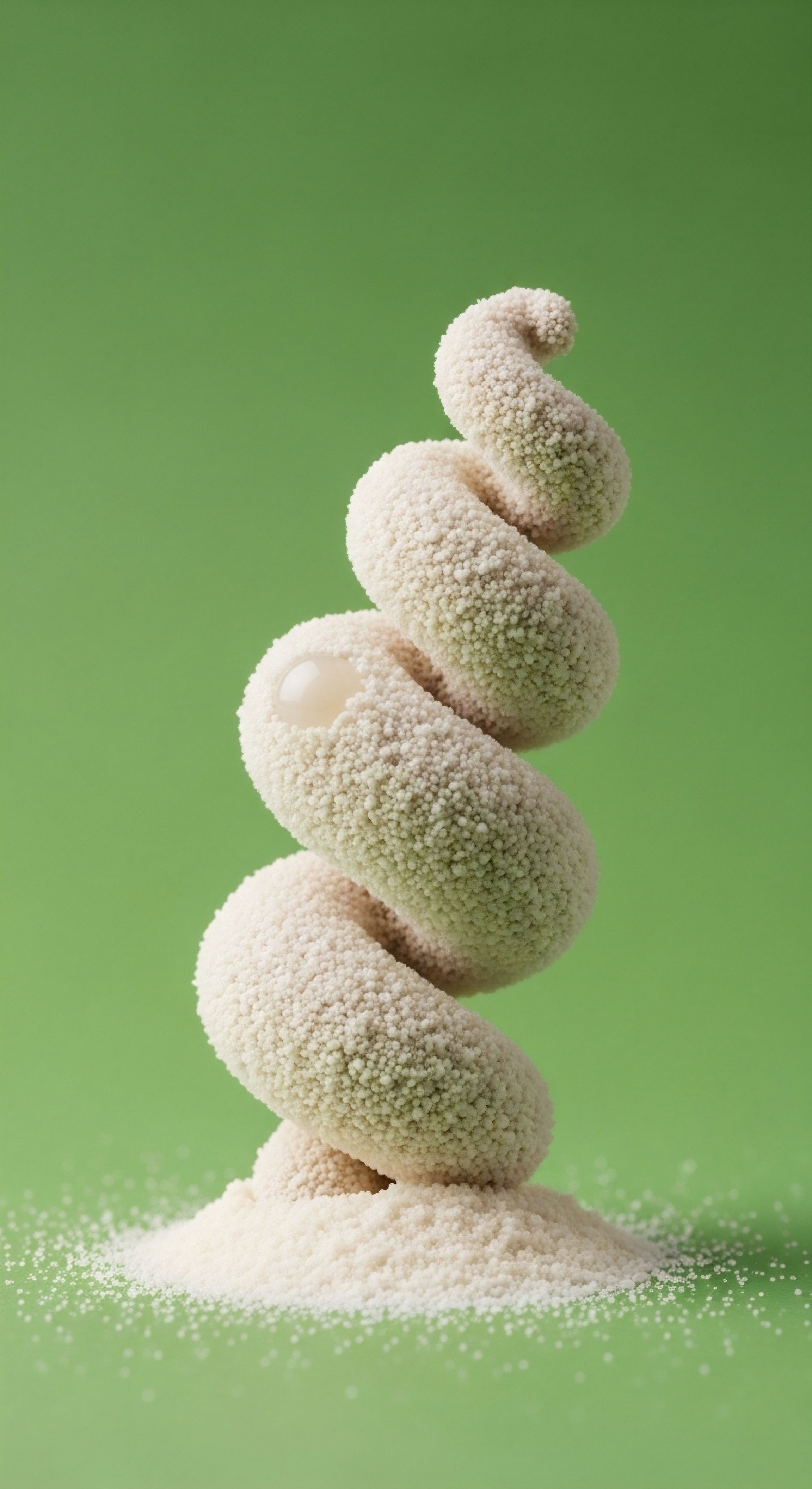

Fundamentals
You may feel it as a subtle shift in your energy, a change in your sleep patterns, or a frustration with your body’s response to your fitness efforts. When you consume alcohol, you are introducing a powerful variable into your body’s intricate internal communication system.
The question of mitigating its effects on your hormones is a profound inquiry into personal biology. It is an acknowledgment that your lived experience ∞ the fatigue, the mood shifts, the metabolic resistance ∞ is connected to the complex biochemical dialogue happening within you every second. Understanding this dialogue is the first step toward reclaiming your vitality.
Your body operates on a series of carefully orchestrated hormonal cascades, a system of messages and responses that governs everything from your energy levels to your reproductive health. Alcohol enters this system as an uninvited chemical messenger, capable of disrupting the conversation at every level.
The core of this internal government is the endocrine system. Think of it as a network of glands that produce and release hormones, which are chemical signals that travel through your bloodstream to instruct tissues and organs on what to do. This system is responsible for maintaining a stable internal environment, a state known as homeostasis.
Chronic alcohol consumption directly interferes with this delicate balance. It disrupts the communication lines between your nervous system, your immune system, and your endocrine glands, leading to hormonal disturbances that have far-reaching consequences for your physiological and psychological well-being. These are not abstract concepts; they manifest as the very symptoms that may have led you to ask this question in the first place. The journey to mitigating these impacts begins with understanding the primary systems alcohol affects.

The Hypothalamic Pituitary Adrenal Axis and Stress
Your body’s primary stress response system is the Hypothalamic-Pituitary-Adrenal (HPA) axis. When you encounter a stressor, your hypothalamus releases a hormone that signals your pituitary gland, which in turn signals your adrenal glands to release cortisol. Cortisol is your main stress hormone; it mobilizes energy, modulates inflammation, and prepares your body for a “fight or flight” response.
Acute alcohol consumption can stimulate this axis, leading to a temporary increase in cortisol. This can create a feeling of activation or energy initially.
Chronic alcohol use, however, leads to a more persistent dysregulation of this system. The body can become less sensitive to cortisol’s signals, leading to a state where the adrenal glands produce excessive amounts to elicit a proper response. This sustained elevation of cortisol has significant consequences.
It can suppress immune function, promote the storage of visceral fat (particularly around the abdomen), break down muscle tissue, and interfere with the function of other crucial hormonal systems, including your reproductive and thyroid axes. The feeling of being “wired and tired” is a classic symptom of HPA axis dysfunction.
The fatigue is real, stemming from cellular exhaustion, while the anxiety or inability to relax comes from the persistent wash of stress hormones. Mitigating this specific impact involves strategies that directly support the calming of this over-activated stress response system.

The Hypothalamic Pituitary Gonadal Axis and Reproductive Health
The Hypothalamic-Pituitary-Gonadal (HPG) axis governs your reproductive function and the production of sex hormones like testosterone and estrogen. This system is exquisitely sensitive to the effects of alcohol. In men, alcohol can exert a multilevel disruptive effect. It is directly toxic to the Leydig cells in the testes, which are responsible for producing testosterone.
Simultaneously, it can increase the activity of an enzyme called aromatase, which converts testosterone into estrogen. This combination of reduced testosterone production and increased estrogen conversion leads to an unfavorable hormonal ratio, contributing to symptoms like low libido, erectile dysfunction, loss of muscle mass, and increased body fat. Studies have consistently shown that chronic alcohol use is associated with lower total and free testosterone levels.
In women, the HPG axis is just as vulnerable. Alcohol can disrupt the delicate, cyclical interplay of hormones that governs the menstrual cycle. It can interfere with the signals from the pituitary gland that trigger ovulation, potentially leading to irregular cycles, anovulation (cycles without ovulation), and fertility challenges.
Both acute and chronic alcohol consumption can alter the balance of estrogen and progesterone, which can exacerbate symptoms of premenstrual syndrome (PMS) and contribute to the hormonal fluctuations seen in perimenopause. For both men and women, a dysregulated HPG axis represents a significant barrier to feeling vital, energetic, and fully functional.
Alcohol acts as a system-wide disruptor, interfering with the fundamental communication pathways that regulate stress, reproduction, and metabolism.

The Thyroid Axis and Metabolic Rate
Your thyroid gland, located in your neck, is the master regulator of your metabolism. It produces hormones that control how quickly your body uses energy, affects your heart rate, and helps regulate your body temperature. Alcohol consumption can directly suppress the function of the thyroid gland.
It can interfere with the production of thyroid-stimulating hormone (TSH) from the pituitary gland, which is the signal that tells the thyroid to produce its hormones. The result can be a state of subclinical or overt hypothyroidism, where the thyroid is underactive.
The symptoms of a sluggish thyroid are pervasive and often overlap with the general feelings of malaise associated with chronic alcohol use ∞ fatigue, weight gain, cold intolerance, constipation, and low mood. Because thyroid hormones are essential for the proper function of nearly every cell in the body, this disruption can have a cascading effect, slowing down your entire metabolic machinery.
This makes efforts at weight management feel futile and contributes to a persistent state of low energy. Understanding this connection is vital, as supporting thyroid function is a key pillar in any strategy to counteract alcohol’s metabolic consequences.

Growth Hormone and Insulin Regulation
Alcohol also has a profound impact on two other critical hormones ∞ growth hormone (GH) and insulin. Growth hormone is released primarily during deep sleep and is essential for tissue repair, cell regeneration, muscle growth, and maintaining a healthy body composition.
Alcohol is notoriously disruptive to sleep architecture, specifically suppressing the deep, slow-wave sleep stages where the majority of GH is secreted. This reduction in GH can impair recovery from exercise, accelerate the age-related loss of muscle mass (sarcopenia), and hinder your body’s ability to repair itself overnight.
Concurrently, alcohol can disrupt your body’s ability to manage blood sugar by affecting insulin, the hormone that allows your cells to take up glucose from the bloodstream for energy. Chronic alcohol use can lead to insulin resistance, a condition where your cells become less responsive to insulin’s signals.
Your pancreas then has to produce more and more insulin to do the same job, leading to high circulating insulin levels (hyperinsulinemia). This state promotes fat storage, increases inflammation, and is a primary driver of metabolic syndrome and type 2 diabetes. The combination of suppressed growth hormone and impaired insulin sensitivity creates a powerful metabolic headwind, making it exceptionally difficult to build a lean, strong, and resilient physique.


Intermediate
To strategically counter alcohol’s hormonal influence, we must move from understanding the problems to implementing targeted biological solutions. This involves a sophisticated approach to diet and lifestyle that provides your endocrine system with the specific raw materials and environmental signals it needs to recalibrate and regain function.
These are not passive recommendations; they are active interventions designed to support enzymatic pathways, provide essential cofactors for hormone synthesis, and modulate the signaling cascades that alcohol disrupts. The goal is to build a resilient internal ecosystem that is less susceptible to disruption.

Nutritional Protocols for Hormonal Resilience
Your diet is the most powerful tool you have for daily hormonal modulation. The macronutrients you consume ∞ protein, fats, and carbohydrates ∞ and the micronutrients they contain are the literal building blocks of your hormones and the cofactors for the enzymes that manage them. A protocol to mitigate alcohol’s effects must be structured and intentional.

Macronutrient Strategy and Hormonal Balance
The balance of your macronutrients directly influences your hormonal environment. A diet that helps stabilize blood sugar is foundational. Since alcohol can induce insulin resistance, a nutritional approach that minimizes large spikes in blood glucose is essential. This involves prioritizing high-quality protein and healthy fats with every meal.
Protein provides the amino acids necessary for building muscle and producing neurotransmitters, which are often depleted by alcohol. Healthy fats, particularly omega-3 fatty acids, are crucial for building the lipid-based structure of steroid hormones like testosterone and cortisol, and for reducing systemic inflammation.
Carbohydrate intake should be strategic. Consuming complex, fiber-rich carbohydrates from vegetables and select whole grains, primarily around your workouts, can help replenish glycogen stores and support performance without causing the dramatic blood sugar fluctuations that exacerbate insulin resistance. Timing is also a factor.
Consuming a balanced meal before drinking alcohol can slow its absorption and blunt the immediate hormonal and metabolic impact. This simple act can reduce the acute spike in cortisol and provide the liver with the nutrients it needs to begin the detoxification process more effectively.

Micronutrients as Hormonal Cofactors
Beyond macronutrients, specific micronutrients are critical for counteracting alcohol’s damage. Alcohol consumption depletes a wide range of vitamins and minerals that are essential for endocrine function.
- B Vitamins ∞ Alcohol is particularly draining on B vitamins, especially B1 (thiamine), B6 (pyridoxine), and B9 (folate). These vitamins are critical cofactors in methylation, a biochemical process essential for metabolizing estrogen and detoxifying alcohol itself. A diet rich in leafy greens, eggs, and lean meats can help replenish these stores. Targeted supplementation may be necessary for those with a history of significant alcohol use.
- Zinc and Magnesium ∞ These two minerals are profoundly important for hormonal health. Zinc is a key component of the enzymes that produce testosterone and is also required for the proper function of the thyroid gland. Magnesium is involved in over 300 enzymatic reactions, including those that regulate the HPA axis and promote restful sleep. Alcohol increases the urinary excretion of both minerals. Replenishing them through foods like nuts, seeds, and legumes is a primary defensive strategy.
- Antioxidants ∞ The metabolism of alcohol generates a massive amount of oxidative stress in the form of reactive oxygen species (ROS). These molecules damage cells, including the hormone-producing cells in the testes, ovaries, and adrenal glands. A diet rich in antioxidants can help neutralize this damage. This includes vitamin C from citrus fruits and peppers, vitamin E from nuts and seeds, and selenium from Brazil nuts. It also includes powerful plant compounds like sulforaphane from broccoli and curcumin from turmeric.
| Dietary Strategy | Primary Hormonal Target | Mechanism of Action | Key Food Sources |
|---|---|---|---|
| Blood Sugar Stabilization | Insulin, Cortisol | Reduces insulin spikes and subsequent cortisol release, mitigating insulin resistance and HPA axis activation. | Lean Protein, Healthy Fats, High-Fiber Vegetables |
| Cruciferous Vegetable Intake | Estrogen | Provides Indole-3-Carbinol (I3C) and Diindolylmethane (DIM), which support healthy estrogen metabolism in the liver. | Broccoli, Cauliflower, Kale, Brussels Sprouts |
| Omega-3 Fatty Acid Supplementation | Cortisol, Inflammation | Lowers systemic inflammation and can help modulate the cortisol response to stress. | Fatty Fish (Salmon, Mackerel), Fish Oil, Algae Oil |
| Zinc and Magnesium Repletion | Testosterone, Thyroid, Sleep | Provides essential mineral cofactors for testosterone synthesis, T4 to T3 conversion, and GABAergic pathways for sleep. | Pumpkin Seeds, Spinach, Almonds, Legumes |

Lifestyle Adjustments to Reclaim Endocrine Function
Lifestyle choices create the environment in which your hormones operate. Strategic adjustments to exercise, sleep, and stress can create powerful signals that directly counteract the disruptive messages sent by alcohol.

Exercise as a Hormonal Regulator
Exercise is a potent hormonal stimulus. The type, intensity, and timing of your training can be tailored to address specific alcohol-induced imbalances. Resistance training is particularly effective. It directly stimulates the release of testosterone and growth hormone, counteracting alcohol’s suppressive effects.
It also increases insulin sensitivity in muscle tissue, creating a “glucose sink” that helps pull sugar out of the bloodstream, thereby improving metabolic health. Two to four sessions of full-body resistance training per week can provide a powerful corrective signal to your endocrine system.
High-intensity interval training (HIIT) can also be a valuable tool, but it must be used judiciously. While it is excellent for improving cardiovascular health and insulin sensitivity, its intensity also creates a significant cortisol response. For an individual whose HPA axis is already dysregulated from alcohol, excessive HIIT can be counterproductive.
Limiting HIIT to one or two short sessions per week, and prioritizing lower-intensity activities like walking on other days, can provide a more balanced approach. Walking, especially after meals, is an underrated tool for improving glucose control and promoting a parasympathetic (rest and digest) state.
Strategic lifestyle interventions, particularly in sleep and exercise, can send powerful corrective signals to an endocrine system disrupted by alcohol.

What Are the Best Sleep Hygiene Protocols for Hormonal Recovery?
Since alcohol’s most damaging effects on growth hormone and cortisol regulation occur via sleep disruption, optimizing sleep is a non-negotiable aspect of recovery. This goes beyond simply aiming for eight hours in bed; it involves creating a strict protocol to maximize sleep quality.
- Control Your Light Environment ∞ Exposure to bright light in the morning, particularly sunlight, helps to anchor your circadian rhythm and reinforces a healthy cortisol awakening response. Conversely, minimizing exposure to blue light from screens in the two to three hours before bed is critical. Blue light suppresses the production of melatonin, your primary sleep hormone.
- Create a Cool, Dark, and Quiet Sanctuary ∞ Your body temperature naturally needs to drop to initiate and maintain deep sleep. Keeping your bedroom cool (around 18°C or 65°F) facilitates this process. Blackout curtains and an eye mask can ensure complete darkness, while earplugs or a white noise machine can block out disruptive sounds.
- Establish a Winding-Down Routine ∞ The hour before bed should be a transition period that signals to your body that it’s time to sleep. This can include activities like gentle stretching, reading a physical book, meditation, or taking a warm bath or shower. The rise and subsequent fall in body temperature from a warm bath can help promote sleepiness.
- Consider Targeted Supplements ∞ Certain supplements can support the neurotransmitter systems that govern sleep. Magnesium, in the form of magnesium glycinate or threonate, can have a calming effect on the nervous system. L-theanine, an amino acid found in green tea, can promote relaxation without sedation. These can be powerful aids in re-establishing healthy sleep patterns disrupted by alcohol.
Implementing these strategies consistently can dramatically improve sleep quality, leading to better overnight GH release, a more regulated cortisol rhythm, and enhanced overall recovery. This is a direct, actionable way to mitigate some of alcohol’s most insidious hormonal damage.


Academic
A sophisticated analysis of alcohol’s hormonal impact requires a deep exploration of the cellular and molecular mechanisms that underpin the observable systemic dysfunction. The disruption of the Hypothalamic-Pituitary-Gonadal (HPG) axis in males serves as a prime exemplar of alcohol’s multifaceted pathology.
The process extends far beyond a simple suppression of testosterone; it involves a complex interplay of direct cellular toxicity, metabolic disruption, neuroendocrine interference, and inflammatory signaling. Understanding this cascade at a granular level reveals precise targets for advanced mitigation strategies.

The Cellular Assault on Testicular Steroidogenesis
The primary site of alcohol-induced hypogonadism is the testis itself, specifically the Leydig cells responsible for testosterone synthesis. Ethanol and its primary metabolite, acetaldehyde, exert direct cytotoxic effects on these cells. Acetaldehyde is a highly reactive compound that promotes the formation of adducts with proteins and DNA, leading to cellular damage and impaired function.
More critically, the metabolism of ethanol within the Leydig cell alters the intracellular redox state. The conversion of ethanol to acetaldehyde and then to acetate by alcohol dehydrogenase (ADH) and aldehyde dehydrogenase (ALDH) enzymes consumes the coenzyme nicotinamide adenine dinucleotide (NAD+) and generates an excess of its reduced form, NADH. This shift in the NAD+/NADH ratio has profound consequences for steroidogenesis.
The synthesis of testosterone from cholesterol is a multi-step enzymatic process. Several key enzymes in this pathway, including 3-beta-hydroxysteroid dehydrogenase (3β-HSD) and 17-beta-hydroxysteroid dehydrogenase (17β-HSD), are NAD+-dependent. The alcohol-induced decrease in the availability of NAD+ directly inhibits the activity of these enzymes, creating a bottleneck in the testosterone production line.
This results in a buildup of precursor hormones like pregnenolone and a significant reduction in the output of androstenedione and, ultimately, testosterone. This is a direct biochemical inhibition, a molecular roadblock placed squarely in the path of male androgen production.
| Biochemical Event | Mediator | Molecular Consequence | Hormonal Outcome |
|---|---|---|---|
| Increased Redox Ratio (NADH/NAD+) | Alcohol Dehydrogenase (ADH) | Inhibition of NAD+-dependent enzymes (e.g. 3β-HSD) involved in steroid synthesis. | Decreased conversion of pregnenolone to testosterone. |
| Generation of Reactive Oxygen Species (ROS) | CYP2E1 Enzyme, Acetaldehyde | Lipid peroxidation of mitochondrial membranes, damage to steroidogenic enzymes. | Impaired mitochondrial function and reduced steroidogenic capacity. |
| Inflammatory Cytokine Production | Kupffer Cell Activation (Liver), Direct Testicular Effects | Increased levels of TNF-α and IL-6, which have direct inhibitory effects on Leydig cell steroidogenesis. | Suppression of LH receptor expression and steroidogenic enzyme activity. |

The Role of Oxidative Stress and Inflammation
Beyond the direct enzymatic inhibition, the metabolism of alcohol, particularly through the microsomal ethanol-oxidizing system (MEOS) involving the CYP2E1 enzyme, generates a substantial amount of reactive oxygen species (ROS). This creates a state of intense oxidative stress within the testicular microenvironment.
ROS, such as superoxide radicals and hydrogen peroxide, inflict damage through lipid peroxidation of cellular membranes, particularly the mitochondrial membranes, which are central to the initial stages of steroidogenesis (the conversion of cholesterol to pregnenolone). This mitochondrial damage impairs the cell’s energy production and its ability to perform its specialized functions.
Furthermore, this oxidative stress triggers an inflammatory response. Chronic alcohol consumption is known to activate Kupffer cells in the liver, leading to the systemic release of pro-inflammatory cytokines like tumor necrosis factor-alpha (TNF-α) and interleukin-6 (IL-6). These circulating cytokines can reach the testes and exert their own inhibitory effects.
TNF-α, for example, has been shown to directly suppress the expression of the luteinizing hormone (LH) receptor on Leydig cells and inhibit the activity of key steroidogenic enzymes like P450scc (cholesterol side-chain cleavage enzyme). This creates a feed-forward cycle where alcohol’s metabolic byproducts cause inflammation, which in turn further suppresses hormone production. It is a systemic inflammatory state that directly targets the machinery of androgen synthesis.

Neuroendocrine Disruption at the Hypothalamic Level
How Does Alcohol Disrupt Central Hormonal Regulation? The HPG axis is a centrally regulated system, and alcohol’s effects are not confined to the gonads. At the level of the hypothalamus, alcohol can disrupt the pulsatile release of gonadotropin-releasing hormone (GnRH), the master signaling hormone that initiates the entire cascade.
This disruption is thought to be mediated by alcohol’s effects on various neurotransmitter systems that modulate GnRH neuron activity. For example, alcohol is known to enhance the activity of the inhibitory neurotransmitter GABA (gamma-aminobutyric acid) and to interfere with the function of the excitatory neurotransmitter glutamate. This net inhibitory effect within the hypothalamus can dampen the frequency and amplitude of GnRH pulses.
Additionally, alcohol-induced activation of the HPA axis plays a significant cross-inhibitory role. The release of corticotropin-releasing hormone (CRH) from the hypothalamus and the subsequent rise in cortisol from the adrenal glands have direct suppressive effects on the HPG axis at all levels.
CRH can directly inhibit GnRH release, and cortisol can suppress pituitary sensitivity to GnRH and directly inhibit testicular testosterone production. This creates a scenario where the stress response triggered by alcohol actively shuts down the reproductive axis. The body, perceiving a state of chronic stress, effectively de-prioritizes reproductive and anabolic functions in favor of immediate survival, a maladaptive response when the stressor is chronic alcohol consumption.

Advanced Mitigation Strategies Based on Molecular Targets
A molecular understanding of this pathology allows for the development of highly targeted mitigation strategies that go beyond basic nutrition.
- Targeting Redox Balance ∞ The shift in the NAD+/NADH ratio is a central problem. While direct oral supplementation with NAD+ has bioavailability challenges, supplementing with its precursor, nicotinamide riboside (NR) or nicotinamide mononucleotide (NMN), may support the cellular pool of NAD+. This could theoretically provide the necessary cofactor for steroidogenic enzymes to function more efficiently despite the presence of ethanol metabolism.
- Combating Oxidative Stress ∞ A robust antioxidant strategy is paramount. N-acetylcysteine (NAC), a precursor to the body’s master antioxidant glutathione, can directly help replenish intracellular glutathione stores that are depleted by alcohol metabolism. This enhances the cell’s ability to neutralize acetaldehyde and ROS. Supplementation with selenium is also critical, as it is a key cofactor for the antioxidant enzyme glutathione peroxidase.
- Modulating Inflammation ∞ Strategies to lower the systemic inflammatory load can protect the testes. High-dose omega-3 fatty acids (specifically EPA and DHA) have well-documented anti-inflammatory properties. Curcumin, the active compound in turmeric, is a potent inhibitor of the pro-inflammatory transcription factor NF-κB, which is activated by alcohol and drives the production of cytokines like TNF-α.
These advanced strategies, grounded in the biochemical realities of alcohol’s impact, represent a sophisticated approach to building cellular resilience. They aim to intervene at specific chokepoints in the pathological cascade ∞ restoring cofactor balance, quenching oxidative damage, and calming the inflammatory storm. This provides a framework for protecting endocrine function on a level that addresses the root causes of the disruption.

References
- Rachdaoui, N. & Sarkar, D. K. (2017). Pathophysiology of the Effects of Alcohol Abuse on the Endocrine System. Alcohol research ∞ current reviews, 38(2), 255 ∞ 276.
- Adler, R. A. (1992). Clinically important effects of alcohol on endocrine function. Journal of Clinical Endocrinology & Metabolism, 74(5), 957-960.
- Rachdaoui, N. & Sarkar, D. K. (2013). Effects of alcohol on the endocrine system. Endocrinology and Metabolism Clinics, 42(3), 593-615.
- Emanuele, M. A. & Emanuele, N. V. (1997). Alcohol and the hypothalamic-pituitary-gonadal axis. In Recent Developments in Alcoholism (pp. 89-116). Springer, Boston, MA.
- Van Thiel, D. H. Gavaler, J. S. & Lester, R. (1978). Alcohol-induced ovarian failure in the rat. Journal of Clinical Investigation, 61(3), 624-632.
- Sarkar, D. K. & Li, Y. (2009). The role of the hypocretin/orexin system in the neurobiology of stress and reward. Substance use & misuse, 44(9-10), 1211-1224.
- Emanuele, M. A. & Emanuele, N. (2001). Alcohol’s effects on male reproduction. Alcohol Health and Research World, 25(4), 282.
- Dees, W. L. Srivastava, V. K. & Hiney, J. K. (2001). Alcohol’s effects on female puberty ∞ the role of insulin-like growth factor 1. Environmental Health Perspectives, 109(suppl 5), 735-739.

Reflection
The information presented here provides a map of the biological terrain, detailing how alcohol interacts with your internal chemistry. This knowledge is a form of power. It transforms vague feelings of being unwell into identifiable processes that can be influenced and supported. Your body is not a passive recipient of circumstance; it is a dynamic system that is constantly adapting. The path forward involves listening to its signals with a new level of understanding.
Consider your own experience in the context of these systems. Where do you feel the disruption most acutely? Is it in your energy and stress response, suggesting an overtaxed HPA axis? Is it in your physical strength and vitality, pointing toward the HPG axis?
Or is it in your metabolism and body composition, implicating your thyroid and insulin sensitivity? This self-inquiry is the starting point for a truly personalized approach. The strategies outlined are tools, and like any tool, their effectiveness depends on being applied with precision and intention. Your personal health journey is a process of discovery, and armed with this deeper knowledge, you are now better equipped to become the primary architect of your own well-being.



